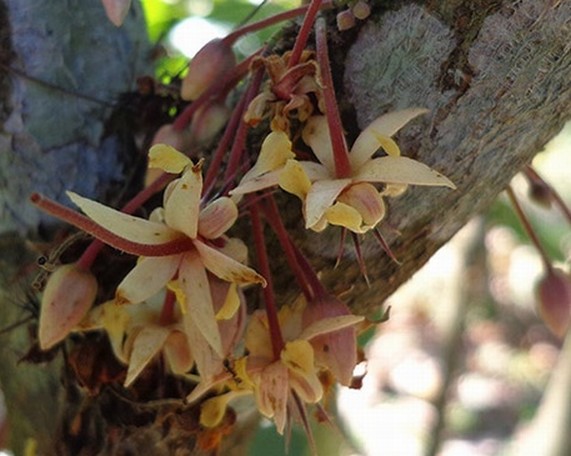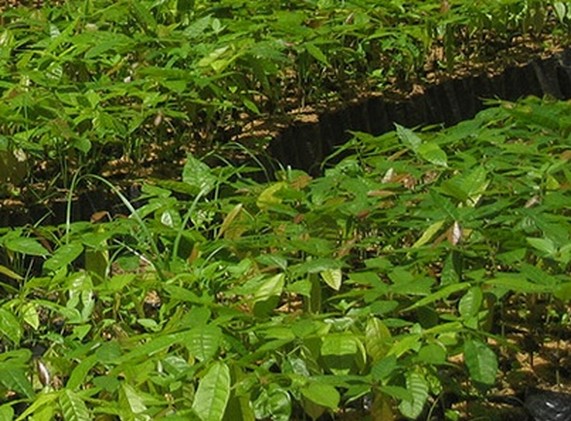Cocoa & Plantations

The determination, the strength, the character, the loyalty....FROM THE COCOA PLANTATION TO THE CHOCOLATE CONSUMER.
We encountered a variety of aromatic cocoa that sparked our enthusiasm. It came from a cooperative in Peru.
Basic Information : Peru has a total area of nearly 4 times the size of Italy, with a population of about 30,000,000.
It has a geography that nuanced and definitive and a history that is even more amazing . Peru is currently experiencing a period of relative political calm .
One of the last dictators to take advantage of the Peruvian people, Alberto Fujimori fled abroad after plundering the State Treasury, resigning from the presidency by fax ....
But that's another story .... We enjoyed the samples, they were excellent.
So get started .......Because we want to know more about the life of this cocoa .....
And because we wanted to know more about its origins, we went to see them, to touch them, to taste them, to breathe where they are born ....in the region of San Martin
COOPERATIVE ACOPAGRO
The cultivation of cocoa is an important alternative for small farmers in San Martin to the often pugnacious influence of the "lords" of cocoa.
A just remuneration to the hard work in the fields has worked to gradually discouraged the severe harassment and bullying that small farmers have long endured. It also demonstrates and highlights an agricultural culture where talent and the farmers' and peasants' desire for progress have given rise to joint initiatives and cooperation.
The cocoa which we are privileged to use for our chocolate was born there.
The cooperative ACOPAGRO has generated and integrated specifications and standards of cultivation, harvest, post-harvest, care for the environment , analysis, research, social support, integration, attention and groundbreaking solidarity.
The product convinced us, we convinced them.
The heart starts to beat faster.
In the next seventy lines you will find complete information about the ACOPAGRO world .
While you read, taste an Otto Chocolate.
In order to grow properly, our cocoa requires special environmental conditions, climate, agriculture and geography. And of course the love, work, passion and expertise that the farmers of the ACOPAGRO cooperative practice with dedicated enthusiasm. They are after all, let us not forget, their native lands, they own, they are the lands where they live, they are the lands that their children will inhabit.

WORK ENVIRONMENT ----?????
There are essential conditions for the development of optimal Organic Cocoa which are:
Shade:
Shade regulates the temperature and excess sunlight on the plantation. Cocoa plants share an environment with the Piane, yucca, palm and coconut trees which provide shade for the cocoa plant in its early stages of growth. And later, as the cocoa matures, shade is guaranteed by taller trees such as Mahogany, Teak , Capirona , Paliperro typical of tropical rainforests and crucial to preserving the ecosystem and the integrity of the terroir.
Temperature:
For plants, it is important that temperature be naturally regulated to ensure the optimum flowering and fruition. Thinning the branches and leaves that shade the cocoa occurs depending on where the plantation is situated, and it is widely believed that areas between 250 and 900 meters above sea level are ideal for the cocoa growth.
The geography and topography of the soil are of equal importance. It is necessary to suppress steep terrain with high slope with barriers and walls to limit erosion and provide stability and security to plants and operators.
Deep and rich soil, with a slighty acidic pH facilitates the penetration growth of strong, which also give the same protection and solidity to the ground.
Of course, the environment, fertile soil, with varied flora and fauna guarantee completeness of natural organic matter and promotes plant nutrition, natural pollination and a holistic ecosystem.
What is more, the climate in general needs to be (and is ..) hot, humid and rainy (though not excessively), to promote lush plant life that is strong and vigorous.
Good ventilation acts as a natural gardener, naturally pruning the plants, freeing them of their withered flowers, twigs , leaves and unripe fruits.
This offers an entirely unique atmosphere and ecosystem, which can absolutely not be reproduced artificially.
Then, the study of the technical aspects of cocoa farming and experience of growers allows the continued improvement of crops via careful pruning, soil and plant maintenance. The vigilant care given in each state plantation of fruit growth from flowering allows for an abundant and timely harvest.
The ACOPAGRO man says "YES" ....

THE WORKING MAN ----?????
As we saw earlier, the development and conversion of many soil varieties for cocoa cultivation allows for increased quality and income derived from the product.
This means that the ACOPAGRO cooperative has garnered the interest and attention of many local farmers.
The next step was to implement the same techniques and to expand similar practices in other areas and plantations, increasing the number of plants and supporting the community with an through cooperation, and assisting the farmer from A to Z.
THE CREATION OF AN ORGANIC COCOA PLANTATION
Obviously, this project did not tome to fruition with a snap of the fingers. The timing and development of this ,and similar projects, spanned a period of years, we have provided a summary of the steps we have taken on our journey.
Identification and availability of suitable ground features, positioning and size.
Soil analysis.
Where considered appropriate, preparation for trial, the design of the plantation and the schema of planting.
Sowing and preparation of shade.
Management and conservation of soil and plants.
Care and verification of efficiency and productivity .
Verification of the features and quality of the cocoa varieties present.
Assistance and control of the phases of pollination, fruiting, harvesting and post-harvest ( fermentation and drying ) .
Bagging, storage, logistics.
Certification and traceability of crops.
Upstream and in conjunction with these aspects also :
Construction, maintenance and management of nurseries (greenhouses ).
Preparation of the plants from seedlings, which will then be planted in the plantation .
The greenhouses, small structures, made on site using local materials and absolutely environmentally friendly. They are positioned in suitable places for size, orientation, and climate .
They use local black soil, exclusively. It is rich in natural organic matter, and similar to that which the plants find themselves once buried in the field.
These lands are mixed, bagged or placed in a mini containers that contain the seeds of the variety of plant one wishes to grow.
The seedlings are cared for and maintained until they reach a size that can facilitate transplantation in the open field, able to react and resist the mood and temperament of the weather ( rain , wind, etc. . ). And , most importantly, ndeed draw nourishment and benefit.
And voila .... as natural as drinking a glass of water or a cup of good chocolate!
Then, a few years later, the exciting first crop of the precious cocoa which, gives life to our chocolate!





